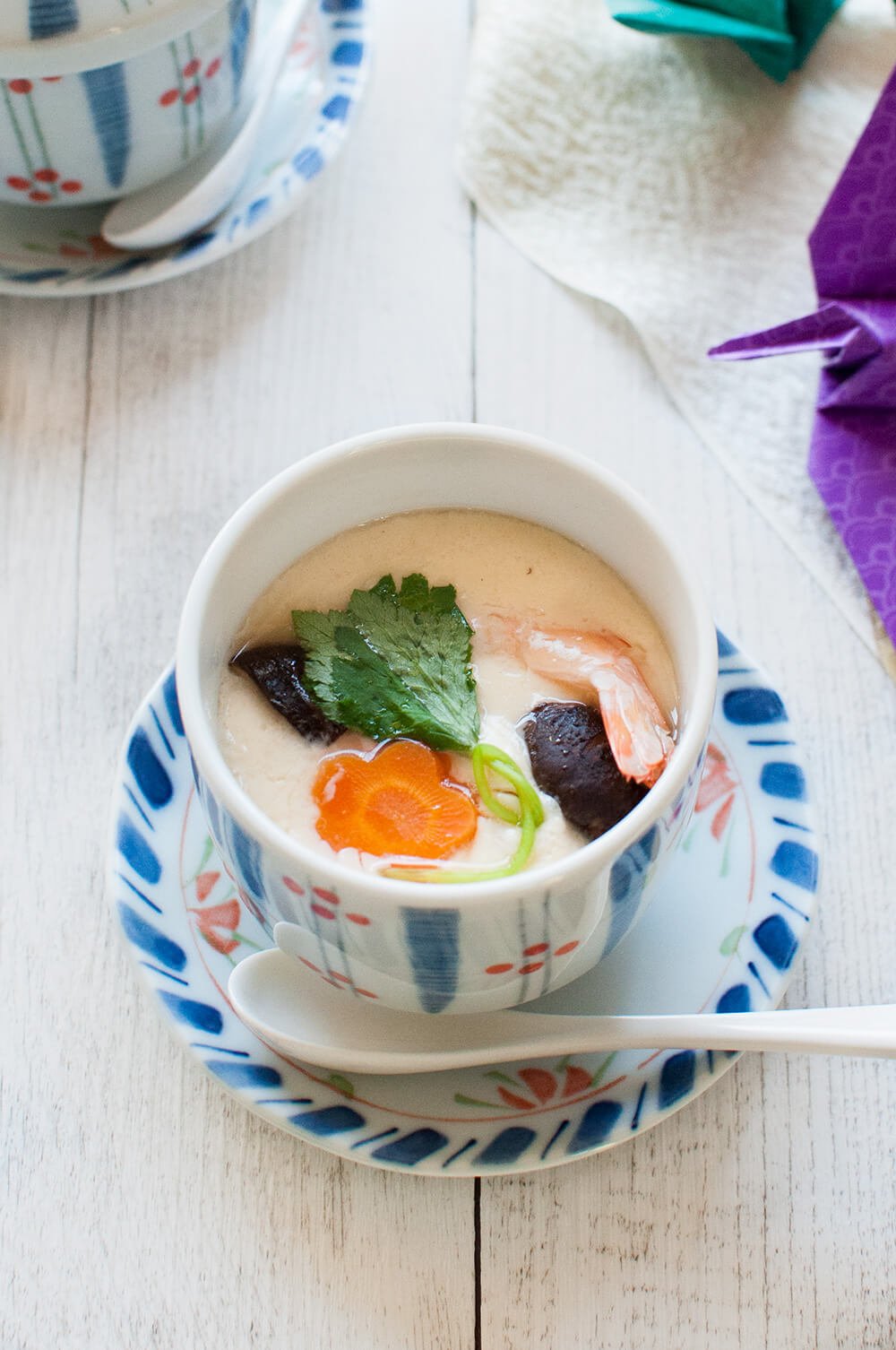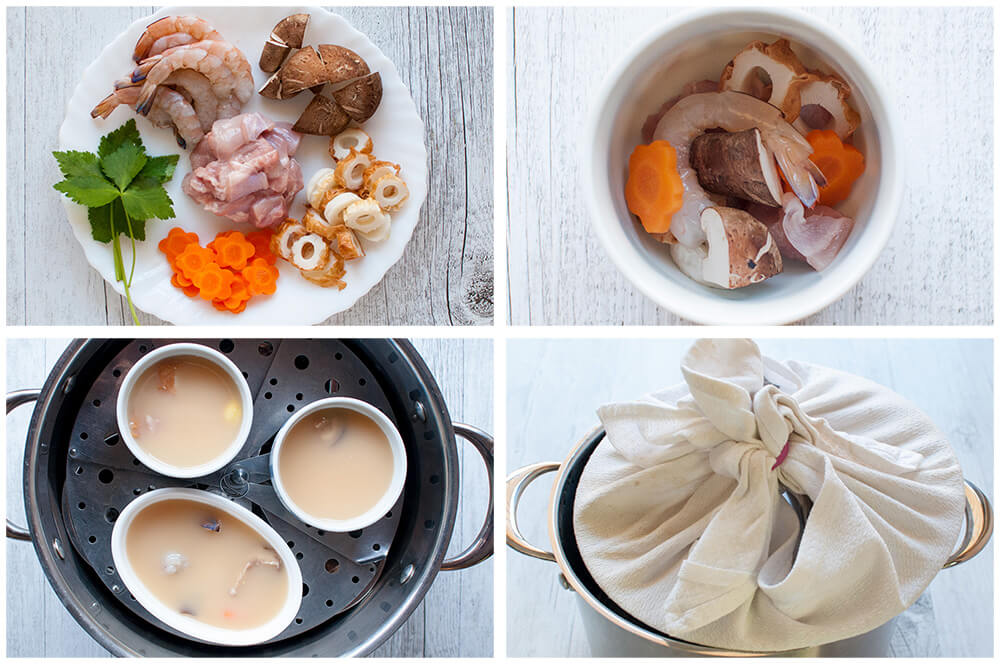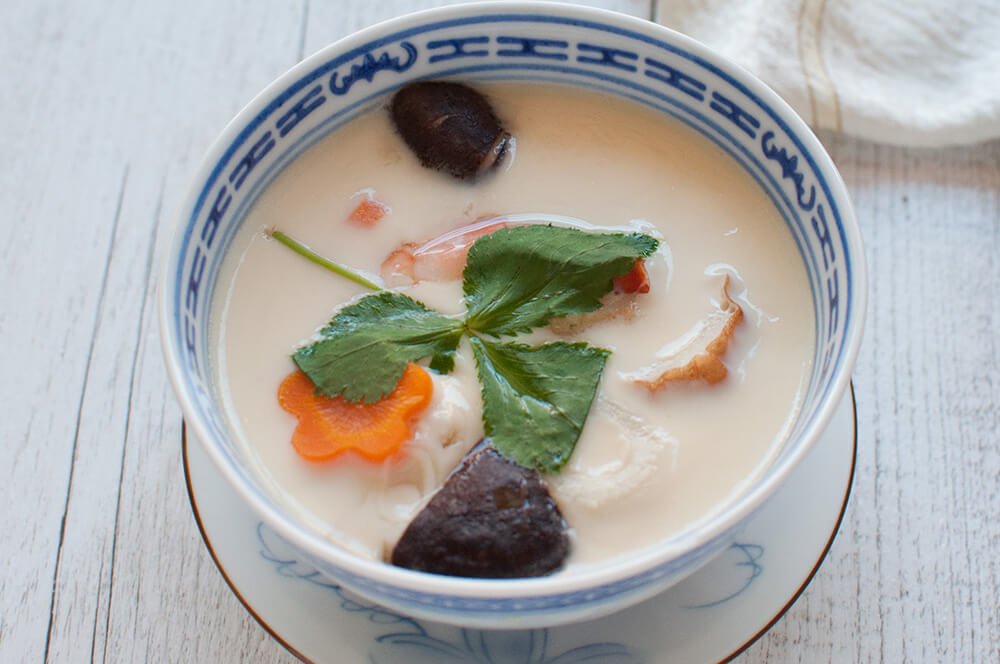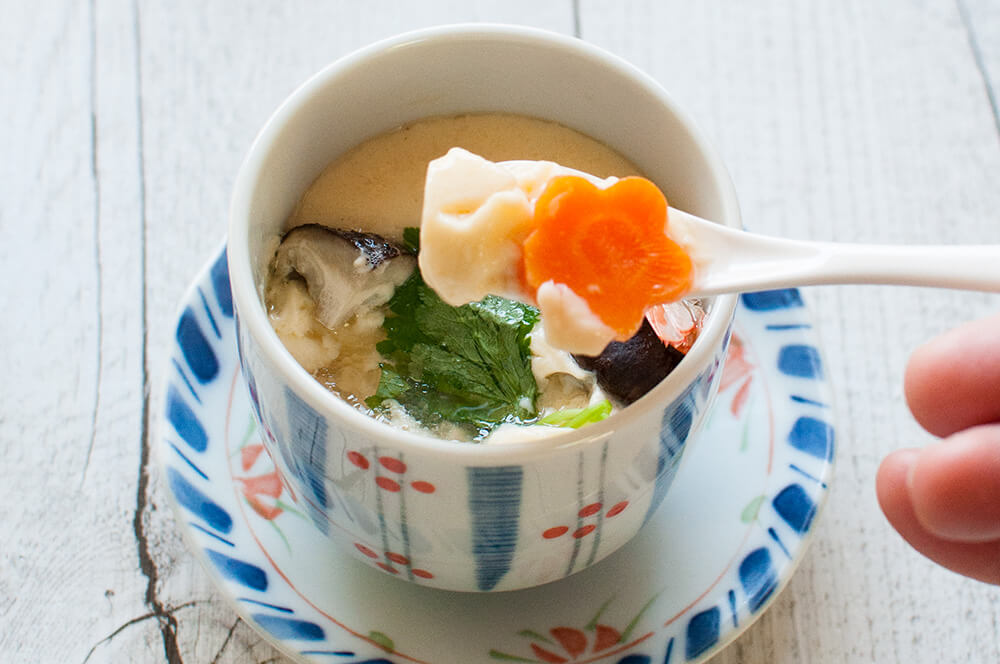One of the few Japanese dishes that is eaten with a spoon, Chawanmushi is the appetiser that is almost always served in Kaiseki ryori. The egg is mixed with dashi, soy sauce, mirin and salt, then carefully steamed with various ingredients in it. The texture of the egg custard is so smooth and delicate.

For those who love traditional custard, it might come across as strange to find a custard dish with no sugar in it. But once you taste it, I am pretty confident that you will fall in love with chawanmushi.
It is such a delicate dish no matter how you look at it – appearance, texture and flavour. No wonder chawanmushi is usually included in Kaiseki ryori at a restaurant or Japanese style accommodation called Ryokan.
Sweet custard is commonly made with just egg, cream or milk and sugar. But chawanmushi consists of savoury egg mixture with numerous small pieces of vegetables and meat.
Typical ingredients are chicken, prawn (shrimp), white meat fish, shiitake mushrooms, kamaboko (steamed fish paste), gingko nuts, carrot and mitsuba (wild Japanese parsley or the Japanese version of Cryptotaenia) as a garnish on the top.
You can be creative and add different vegetables that do not have a very strong flavour and are suitable for steaming. I sometimes use sliced bamboo shoots, green beans, edamame (green soy beans), shimeji mushrooms, enoki mushrooms, chikuwa (grilled fish cake stick). I usually do not have mistsuba so I substitute it for snow peas, spinach, snow pea shoots or mizuna.
Today, I was lucky to find mitsuba at the Japanese grocery store. So my chawanmush included chicken, prawns (shrimps), shiitake mushrooms, chikuwa, carrots and mitsuba (see the top left photo below).

From top left, clockwise: My chawanmushi ingredients; all but mitsuba are placed in a steaming cup; steam with wrapped lid on but slightly opened; even ramekins can be the steaming cup.
The word “chawanmushi” (茶碗蒸し) literally translates to steamed tea cup. As such, the egg mixture is poured into a tea cup with ingredients in it, then steamed. There is a special tea cup for chawanmushi which comes with a lid and a saucer which I used in the first photo. The capacity of the cup is about 200ml which is just the right volume for one serving.
I bought 6 sets of chawanmushi cups when I went to Tokyo many years ago from the famous kitchen town called Kappabashi – about 20 minutes’ walk from Asakusa. It was quite a nuisance to carry back cups and plates in my luggage, but I was very satisfied and happy that I brought back 6 of them without breaking any. That was until I found exactly the same chawanmushi cup and lid at the Japanese grocery store in Sydney…the fact that I got them much cheaper in Japan was the only consolation.
You don’t have to have a special chawanmushi cup. You could use a rice bowl (see the photo below using a small Chinese bowl), a tea cup, a mug or a ramekin (see the bottom left photo in the previous photo with an oval ramekin in the steamer).

TIPS FOR PERFECT CUSTARD
Perfect chawanmushi should be smooth on the surface and very soft when scooped (much softer than panna cotta). There are a few tips for making a perfect chawanmushi and once you know them, it will become so simple.
- The golden rule of Egg to Dashi Stock ratio – the ratio of the volume (not weight) of egg and dashi stock is 1:2.5. Many of the chawamushi recipes list the number of eggs required in the ingredients. But the size of each egg varies and it could result in the wrong consistency of steamed custard. If the eggs are very small, the custard will be watery. Very large eggs will make the custard a little bit harder.
- Drain the egg mixture through a sieve before pouring into the tea cup – yes, it means an extra utensil to wash but this extra step makes the silky texture of steamed custard.
- Gentle steaming – the steamer needs to be on high heat with a lid on initially for a minute or so but then reduce the heat to gently steam, with the lid slightly shifted to allow the steam to escape. If the steaming power is too strong, it will make the surface of the chawanmushi porous and spongy.
- Warp the steamer lid with a tea towel – chawanmushi is steamed without a lid on each cup. By wrapping the lid with a tea towel, it will prevent the water accumulated on the lid from dropping onto the surface of chawanmushi.

I love chawanmushi. What I love most about chawanmushi is the delicate flavour and texture of the custard. Also, when I dig into the custard and find small pieces of different ingredients, I feel like I am on a treasure hunt expedition. It is kind of fun.
Chawanmushi is one of my younger daughter’s favourites as well. Actually, she loves anything to do with eggs. By the time I finished the photo taking of chawanmushi, I had eaten so many chawanmushi, due to trialling different cups and mistakes etc, and got sick of it. So I even drove to my daughter’s work place in the city to pass on some of them (ie. get rid of them) .
Yumiko![]()

One of the few Japanese dishes that is eaten with a spoon, Chawanmushi is the appetiser which is almost always served in Kaiseki ryori. The egg is mixed with dashi, soy sauce, mirin and salt, then carefully steamed with various ingredients in it. The texture of the egg custard is so smooth and delicate.
The cook time assumes that a steamer or a pot is used to steam. If an oven is used, the cook time will be 25 minutes longer.
- 8 small prawns , head and shell removed, deveined (note 1)
- 80g (2.8oz) chicken , diced into 12 pieces (about 2cm (2¾") cubes)
- 8 x 4mm thick sliced carrots shaped into flowers (note 2)
- 2 medium size (5cm (2”) in diameter) shiitake mushrooms, cut into quarters
- 1 small chikuwa (grilled fish paste) stick, sliced into 16 pieces (note 3)
- 4 stems of mitsuba (note 4)
- 400ml (13.5oz) dashi stock (note 6)
- 1 tsp light soy sauce (note 7)
- 1 tsp mirin
- ½ tsp salt
- 150ml (5.1oz) egg (3 x about 60g (2.1oz) egg), beaten wel
-
Prepare 4 x tea cups (or small deep bowls) of about 200ml (6.8oz) capacity (note 8) that can be heated in steamer.
-
Place equal amount of all the Chawanmush Ingredients excluding mitsuba in each tea cup.
-
Mix dashi stock, soy sauce, mirin and salt until salt is disolved. Add the beaten egg and mix well.
-
Place a sieve over a measuring cup or a bowl and pour the egg mixture through the sieve. This will remove the lumps of egg white and improve custard consistency.
-
Add equal portions of the egg mixture gently into each tea cup. If there are small bubbles on the surface, remove them. I use the edge of a kitchen paper to do that.
-
Bring the steamer to the boil. If the lid of steamer is likely to drip water while steaming, wrap the lid with a tea towel, tied at the handle of the lid.
-
Place the tea cups inside the steamer and boil on high heat for 1 minute with the lid on.
-
Reduce the heat to low and shift the lid about 1cm so that the steam can escape (to make it a gentle steam and avoid the custard bubbling).
-
Steam for about 18 minutes or until the custard is set (note 9).
-
You will need a large pot, a plate that will just fit inside the pot, and either 3 small ramekins or 3 balls of the same size made by scrunching aluminium foil (these are to lift the plate above the water level).
-
You will also need to wrap the lid of the pot with a tea towel, tied at the handle of the lid.
-
Add two cups of water to the pot. Place the ramekins or aluminium balls in a triangle position and place the plate on top of them.
-
Turn the heat on high and bring it to a boil.
-
Follow step 2 onwards of Steam Using a Steamer.
-
Pre-heat the oven to 180C (350F).
-
Fill the baking tray with 1cm (⅜") depth of water.
-
Place chawanmushi cups inside the tray and cook for 35 minutes.
-
Turn the oven off and leave for 10 minutes.
-
Chawanmushi should be served immediately with a spoon. This is one of the few Japanese dishes that requires a spoon to eat.
1. My prawns were small and weighed 65g (2.3oz) in total once peeled. I left the tail shells intact for presentation reasons but you don’t need to do that.
If the prawns are large, you need to cut them into bite size pieces.
2. You don’t need to shape the carrots into flowers but if you want to, please visit my recipe Sanshoku Bento (Tri-coloured Rice Bowl), Note 1.
3. You can buy frozen chikuwa at Japanese grocery stores or some Asian grocery stores. They are shaped like a log of about 10cm (4") long with a hole in the centre. There are sold in a pack of 5.
My small chikuwa was just over 30g (1.1oz).
Instead of chikuwa, you could use other fishcakes that are not deep fried.
4. Mitsuba is a wild Japanese parsley or the Japanese version of Cryptotaenia. Japanese grocery stores usually stock fresh mitsuba. Instead of mitsuba, you can use other green leaves such as mizuna, spinach or even snow peas.
5. The golden rule of the egg:dashi:stock ratio is 1:2.5 respectively. If you prefer harder/softer custard, then you will need to reduce/increase the quantity of dashi stock slightly against the quantity of egg. But the quantity of dash should not be more than 3 against 1 portion of egg.
6. Please visit Home Style Japanese Dashi Stock.
7. I use light soy sauce so that I can maintain the light cream colour of chawanmushi. But you can use normal Japanese soy sauce. Dark soy sauce should be avoided as it will make the egg mixture too dark and unattractive.
8. You can use larger or smaller size cups or bowls to make chawanmushi. If using smaller cups, there will be too much egg mixture and for larger cups, it will not fill up the cup. You will need to adjust the number of cups or the amount of egg mixture accordingly.
9. The time required to steam chawanmushi varies depending on the size of the cups and the strength of the heat. As long as they are steamed with gentle steam, they should cook with a smooth surface, even if steamed slightly longer. Strong steam or prolonged steaming will cause the custard to bubble.
10. It is best to serve immediately while chawanmushi is still fresh and hot. If you can't, store it in the fridge and re-heat it either in a pot with 1 cm boiling water for 5-10 minute or in the oven at low temperature for about 15-20 min.
Delicious, authentic tasting, delicate and devoured. We loved it.
Thank you so much!
Yumiko,
I was just gifted two wonderful lidded chawanmushi vessels. Today I tried your chawanmushi recipe. I carefully divided the ingredients in half but other than that and being unable to source the fish cake, I followed it to the letter. On the whole it worked relatively well but the shrimp, chicken and carrots all sank to the bottom and were not at all visible. Also, there was a fair bit of clear liquid beneath the egg custard. I cooked them in the oven in a pan of water at 350°F for 35 minutes. Can you offer any suggestions as to how to improve my next attempt? Thank you as always for your efforts and your lovely website.
Anna
Hi Anna, the balance between the quantity of egg and dashi to make the right amount of liquid left at the bottom is quite delicate. It is also influenced by the temperature of steaming. I would suggest that you reduce the dashi stock slightly or increase the amount of egg slightly and see how it turns out.
Regarding the ingredients not floating, I tried to pile the ingredients high where possible so that pieces such as carrot, prawn will be placed almost above the egg mixture. This can be done more easily of the chawanmushi cup is a shallow cup. Alternatively, add few pieces that you want to show on the surface mid-way during the steaming.
Thank you so very much. I will give your suggestions a run through in the next couple of days.
Anna
Would having the pieces of sliced shrimp, carrots etc. be more for aesthetics- appetite appeal than flavor? Like your photos? Thank you for the other tips – too soupy , different substitutions etc.
Hi Linda, yes and no would be my answer. The flavour of savoury custard is definitely the strongest in Chawanmushi, but these ingredients give you layers of different subtle flavours and textures, in addition to making the dish look pretty.
Hello yumiko, for some time I have wanted to do chawanmushi but I have some problems:
Where I live it is impossible to get ginko nuts, could you replace them with peeled almonds or another kind of nut?
Also tea cups are hard to come by, could you use ramekin molds? Also, lately I use granulated dashi, how much would I have to use for this recipe?
Finally, how to cook chawanmushi (not close the pot completely) could also work for the japanese custard pudding?
Hi Ruth, alternative to ginkgo nuts would be either broad beans or edamame (if you can get them). You can also omit them. Other nuts are probably not suitable as they should be tender, not crunchy.
Ramekin is perfectly alright to use for chawanmushi.
To make 400ml (13.5oz) dashi stock, add a bit less than 1 teaspoon of granular stock.
It is the same concept to steam custard pudding but ingredients are different, naturally.
I found these nuts on ebay, but they say they are ginkgo nuts, are these used in chawanmushi?
https://www.ebay.com/itm/MUJI-Fried-Ginkgo-Nuts-30g-Japanese-Food-Japanese-Snack-New/112553607905?epid=2231450484&hash=item1a34b7c2e1%3Ag%3AhogAAOSwDcpZr0Yw&_sacat=0&_nkw=ginkgo+nuts&_from=R40&rt=nc&LH_TitleDesc=0
Hi Ruth, yes they are the ginkgo nuts used in Chawanmushi. I did not use it in the recipe but mentioned gingko nuts as one of the typical ingredients in the post.
Made this(chawanmushi) today, at last, and your proportions were spot on.
The texture was delightful.
Hardest thing was finding the right sized dishes, I used Indian katori, a bit cross-cultural but they worked well.
Thanks for the attention to detail that makes your blog so interesting and your recipes so successful.
Hi Miriam, that’s great. I’m glad that you found suitable dishes for chawanmushi. Indian katori is a good idea.
My kids love Japanese custard after visiting there two years ago. Thanks for all these tips. I was wondering, can you use a slow cooker to steam them too?
Hi Amita, I don’t have a slow cooker so I cannot comment on this based on my experience. However, I read few articles on the internet and it says you can. Quite successfully!
Fill water up to half way to the chawanmushi cup and turn the switch on high for 1 hour. This is assuming that you are using standard chawanmushi cups. If the cup is much smaller/larger, cooking time would need to be adjusted. You may need to check a couple of time to see the exact time required.
My mother used to make this for me when I was sick and I always loved it. She simply called it “Japanese Custard” (We came to the US in 1959). The texture and bright flavor was perfect. I was actually just remembering it the other day and wondering if I could find the recipe. My mom has been gone for over 20 years and I still miss her. I am grateful for the recipes you share. Thank you so much!
Hi June, I am glad that I could help you with remembering a good memory of your mother. I hope my chawanmushi is as good as your mum’s!
Hi, I’m living Auckland New Zealand.
I’m surely we have quite similar ingredients with in Australia. I’m very enjoyed your site.
Chawanmushi, one of my favorite food, but, for Kiwis, not really popular.
My kiwi husband says it is different and cool one is taste better. Friend of mine running Japanese restaurant in here says probably they have no idea what is it.
What about your Aussie friends around you says?
Hi Azumi-san, I am glad you are enjoying my blog.
I once invited my friends for Kaiseki dinner and served chawanmushi. There were 6 of them and people who love Japanese food liked it. But one person who loves sweets said it was a bit strange to have custard without sugar and she said she did not enjoy it.
I am guessing that people who really like sweets and dessert may not enjoy it. Because they think something is not right. Also, people who like strong flavours probably find that chawanmushi flavour is too subtle.
The set meals at the Japanese restaurant down the street often includes this. I’ve never been sure what it was, so I clicked through to find out, thank you for explaining it and the recipe. I won’t be making it, as I don’t much like it. I was never sure what it was, as the custard makes me think of dessert, but the random chunks of unidentifiable food made me think appetizer. At least I now know what it is. It’s been a while since I’ve eaten at the restaurant, but as I recall, they usually put chicken gizzards in theirs.
Alex, are you sure the chawanmushi had gizzards in it? I have never heard of. It should have normal chicken meat, i.e. thigh, breast, or tenderloin. You might like it if chicken meat instead of gizzards.
Your CHAWANMUSHI looks incredible. I’ve only had it a couple of times and loved it, haven’t found in our local sushi joints.
I’m going to give this a try in my Instant pot set for steaming.
Thanks so much for the lovely posting.
Thank you! Please do try. You will find it so easy to make. Let me know how it went.
Ha! Did T go mental when you gave them to her? Did she have them straight away???
Yes, of course. Tamaki even had to ask me how to re-heat! But now the recipe is out, she can make them herself.
Anyway, she said they were FANTASTIC. I bet she ate two of them at once.